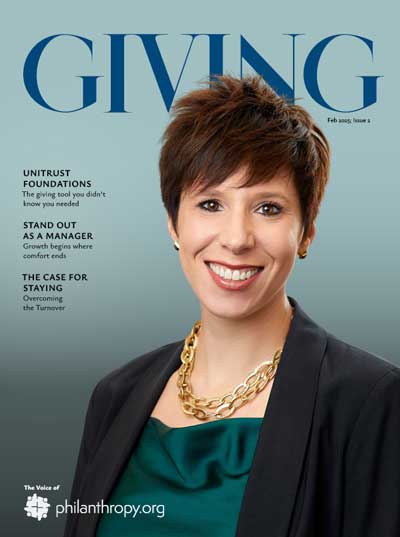The 2024 Edition
Viken Mikaelian with Patrick O'Donnell
As long as technology has existed, there’s been a perception that seniors are not just slow to adopt it, but resistant to use it. The advent of the computer age in the 20th Century thrust that perception into the spotlight as younger generations raced toward the digital age and older generations held back.
But the writing was on the wall, and savvy businesses and organizations moved first toward informational websites, and then to digital commerce. In 1999, PlannedGiving.Com (then VirtualGiving.Com) saw the future of philanthropy and became the first to offer nonprofits a planned giving website.
Get 'Smart'
Now, in the 21st Century, computers, tablets, and smartphones are ubiquitous. Even our TVs are “smart.” For better or worse, AI is taking center stage as the next big thing. Donors expect their favorite nonprofits to not just have a planned giving program, but also a planned giving website — and we know those websites work.
Still, there are fundraisers who say things like, “Our donors are all elderly, so they aren’t online.” That’s why, in 2002 and again in 2017, we dove into research on the role that technology plays in the lives of senior citizens. Both times we surprised the skeptics.

Seniors on the Internet
2002 Edition [Download]
In our 2002 article, The Future of Planned Giving [PDF], we showed that nonprofits needed to ditch the misconception that seniors were not using technology, and alter their marketing plan. Here’s what we found, in the days before smartphones, tablets, and social media:
- Adults 55+ were the fastest growing sector of the PC-purchasing public.
- 40% of all U.S. adults over the age of 50 — including 24% of those over 65 — used a computer at home.
- 70% of seniors who owned a computer used the Internet on a regular basis.
- 65% of the Americans age 55+ who were online used the Internet for investing.
Fifteen years later, our “Seniors on the Internet” white paper showed a leap not just in technology — adding smart phones and social media to the mix — but in its adoption by older generations. For instance, a stunning 82% of Baby Boomers (ages 73 to 53) belonged to at least one social network, and 71% of that group used social media every day. Four in ten (42%) adults 65 and older reported owning smartphones, and 67% of seniors used the internet.

Hold on to Your Hat
We’ve been doing some digging to update those facts and figures for 2024, because there are still naysayers. This time, however, what we learned about seniors and technology should blow those skeptics completely out of the water.
According to a 2023 AARP study, almost nine out of 10 Americans own a smart phone. No surprise there, perhaps. But of them, 89 percent are 50-plus (a prime planned giving prospect age), and 90% are between 18 and 49 (there’s planned giving prospects in this group, too). Furthermore, those in the 50-plus group were just as likely to own a tablet or other device as their younger counterparts.
But wait, there’s more: While overall spending on technology dropped, from $912 per person in 2022 to $798 in 2023, tech purchases by adults in their 60s and 70s went up. “In the last year, 69% of adults over 50 bought at least one tech product,” the AARP study states. And the 50-plus set’s tech spending is only expected to increase, from $140 billion in 2018 to $623 billion by 2050.
Older adults’ confidence in their tech skills is up, too. The study found 72% of adults between 50 and 59 feel that they have the digital skills needed to “fully take advantage of being online. Among those 70-plus, that number dips slightly, but is still at an impressive 61% percent.
What’s more, a 2021 AARP study found that:
- More than half (59%) of older adults use social media at least weekly.
- To stay in touch, 94% of older adults text, 88% use email, 74% are on social media, and 67% use video chat.
- The use of smartphones (for more than phone calls) by those 50-plus has increased dramatically. For instance, use for ordering groceries grew from 6% to 24%; use for personal health (telehealth visits, ordering prescriptions, making appointments) increased from 28% to 40%; use for health and fitness information increased 25% to 44%; and use for financial transactions increased 37% to 53%. This means your website needs to be optimized for mobile devices, not just desktops!

The Net Worth Connection
It’s obvious that most older adults use some kind of technology every day — from smart phones to tablets to desktop computers and beyond. And every year, that number increases.
Now here’s the reason that’s so important: According to Federal Reserve data, Americans aged 65 to 74 have the highest average net worth of all generations: $1,794,600. Those 55 to 64 come in second, with an average net worth of $1,566,900. And according to the National Association of Charitable Gift Planners, the average age for making a first planned gift is 53!
Now, while that doesn’t mean all planned gifts come from our oldest generations, it does mean the majority of your planned giving prospects will be from the Silent Generation (1925-1945), Baby Boomers (1946-1964), or Gen X (1965-1980). And the Great Wealth Transfer is predicted to see up to $140 trillion transferred between generations.
Furthermore, the number of Americans 65 and up is projected to increase by 47 percent, from 58 million in 2022 to 82 million by 2050.
Finally, according to The Federal Reserve’s Survey of Consumer Finances, net worth in the United States is steadily rising.
- Median net worth is $121,700, up 17.6 % from 2016.
- Average net worth is $748,800, up 2% from 2016.
- The top ten percent of households own 76% of U.S. wealth.
- The bottom 50% of households own just 1% of U.S. wealth.
So, what’s the bottom line? While a mix of marketing styles (print and digital) is still the best way to reach your prospects, you’re missing out on a fortune in potential donations if you ignore the digital side. Your audience is using technology to manage their portfolios, pay bills, research nonprofits, and, yes, make donations.
You need a planned giving website that’s mobile friendly. You need a robust digital marketing program. And you need to keep your finger on the pulse of technology and adapt as needed. That doesn’t mean you should jump on the next shiny object. It does mean you should take a measured, planned approach to digital marketing for your planned giving program.



